Retro recipe
Dragon Ball Z

This is a fun retrospective with an extra kick for DBZ fanatics, ideal for when you notice that regular retrospectives are becoming stale or are losing their worth and you want to reinspire the team towards continuous improvement.
Ingredients
- A (free) Miro account
- The DBZ template board
- An internet-connected device for all participants
- When not remote: one laptop, sticky notes, and pens
- Your awesome team
- Good mood
- Trust
Mise en place
Step 1: Create a team on Miro
Once you have logged in with your free Miro account, click the ‘+’ button on the left to create your team. You will need at least one team before you can proceed to step 2.

Step 2: Duplicate the Miro board
All Kudos and credits to Dave Westgarth for creating the Miro template we are using today. You can find more on his website.
Visit this link to the DBZ board. If you have a Miro account, you will see a label at the top of your screen that allows you to duplicate the board.

Click "Duplicate" and confirm.
Alternatively, you can click the cogwheel button in the top-left corner, select "Board", and choose to make a copy. Miro will give you the possibility to duplicate the board. Once the duplicate board has been created, a pop-up window will offer a link to the board.

Step 3: Unlock all elements on the board
Once the board has been duplicated, visit it. Zoom out using the scroll wheel (or the controls in the lower-right corner) until you see the entire board. You will notice that, when selecting one of the sticky notes, these sections are not yet interactive. When you select something, however, a pop-up label should appear, allowing you to unlock the elements. Long press the button to turn the board editable. Optionally, you can also remove the “DO NOT EDIT” sticky note.

Step 4: Invite your team
On your Miro dashboard, click the “Share" button and
- enter the mail addresses of your team members to send out invitations, or
- send the invite link to your team members.
Cooking
Step 5: Grip on the retrospective
GRIP: Goal, Roles, Interaction, Planning
Goal: Explain the goal of the retrospective, which is to evaluate the last iteration in relation to the people, the tools, and the processes used.
In this specific instance, using the Dragon Ball Z board should allow you to uncover some underlying thoughts that might not have been discovered during a classic retrospective.
For us, one of our goals is to always create one or two action points based on the evaluation that was made.
Roles: distribute roles.
Assigning a role to people in the retrospective makes sure they are always focused and have something to do other than participate. The following roles can be distributed:
- Facilitator: Facilitates the meeting by introducing the different topics and asking broad questions… Often this will be the Scrum Master/Agile Coach, but the facilitator can be anyone if they feel comfortable with this specific board. It can be useful to have a facilitator with some Dragon Ball Z knowledge to provide the participants with a bit more context for the board.
The facilitator makes sure everyone stays on topic and helps steer the discussion toward the goal of the retrospective. - Timekeeper: Keeps track of the time for each part of the retrospective. Keeps an eye on the timebox.
- Notetaker (optional): Takes notes on the board. This role is only necessary if not everyone has a device they can directly participate with on the board. Otherwise, everyone should feel free to take their own notes.
When discussing the topics, you could, for instance, add extra sticky notes by selecting the "sticky note" button in the sidebar on the left-hand side of the Miro board or by pressing "N" on your keyboard.

Interaction
Clarify to everyone that a good retrospective (and by extension a good SCRUM team) is based on trust and open communication. This only works if everyone is willing to share their thoughts and actively listen to others.
Planning
Explain what the meeting will look like within the timebox:
- Icebreaker: 10 minutes
- Rate the previous sprint: 5 minutes
- Discussions: 1 hour
- Summary and highlighting of action points: 7 minutes
- Rate the retrospective: 3 minutes
Feel free to add a 5 min break somewhere in the middle if you notice the focus is dropping.
Step 6: Icebreaker (10 minutes)
From here on out, either:
- Everyone is allowed to take notes on the board at any point
- At the start of each topic, everyone writes their items on a sticky note and the notetaker types those out on the board
Everyone adds a sticky note, here referred to as "ticket", with on there a wish they have. Whether or not this is related to the iteration or even the team is totally up to you!
Note: The goal here is to remain anonymous, so the preferred way of working is to first write your wish on a sticky note and then have the notetaker post all collected notes to the board. If you do not do this, it is exceedingly difficult to remain anonymous, as the board shows you who is typing where (even with the “Collaborator’s cursors” turned off). There might be a “private mode” on Miro that we did not discover...
Once all wishes have been written down, the notes are read out loud and the team tries to guess whose wish is whose.

Step 7: Super Saiyan Scale (5 minutes)
Every team member places a dragon ball on the Super Saiyan scale to rate the last iteration. The results can be discussed, but remember to keep an eye on the timebox.

Step 8: Retrospective board (1 hour)
Each topic mentioned on the board gets 10 minutes on average. If you prefer this, you can start off with 5 minutes and use a voting system to decide whether or not to keep the discussion on some topics going. If you do this, the role of the timekeeper and the facilitator becomes very important!
Generally, we start off with one or two minutes to formulate our initial thoughts and use the rest of the time to discuss them.
You can further divide up the timebox for each sticky note separately, but remember that deciding on the timebox also takes time!
Step 8.1: Healthy rivalry (10 minutes)
Each member describes an environment in which they perform best and that pushes them to improve. For some people, this will be a high-pressure environment with a lot of focus switching, for others this could be the other way around, or something completely different still.
Discuss how you can take a step towards creating that ideal environment for everyone to thrive in.

Step 8.2: “It’s over 9000!!” (10 minutes)
How can we improve ourselves? This can apply both to yourself and to the team.
Discuss how we can not only think about these improvements but also how to do them!

Step 8.3: Bad guys incoming (10 minutes)
Think of challenges you can see coming or challenges you're already facing but have no solution for yet. Describe these challenges first and then discuss with the team how they can be faced head-on.

Step 8.4: There’s one thing a Saiyan always keeps: pride! (10 minutes)
Here, we focus on things we did this sprint that we’re particularly proud of. This can be individual, but also team-oriented. Maybe there was a difficult issue, yet you powered through and found the solution. Maybe the team really planned this sprint with ultimate convenience in mind. Maybe the stakeholders were adamant that you went above and beyond with this iteration.
Even here, action points can be formulated by figuring out what made this happen and how we can keep the momentum going.

Step 8.5: Fusion! (10 minutes)
Figure out which collaborative opportunities made you into a better version of yourself this sprint. Where was 1+1=3 or 1+1+1=5? This can exceed your team’s boundaries as well!
Discuss how you can keep those synergies going. Are there other fusion opportunities like this?

Step 8.6: New levels (10 minutes)
What good ideas do you have to further your own or your team’s development? This could perhaps be something you already started this week that had a very positive effect and that should be made into a policy for the team?
These will be very actionable topics. Discuss whether they are actually a positive evolution for the team and how you can steer yourselves in that direction.

Step 9: Summarize the retrospective (7 minutes)
Have a quick look at all the topics you covered on this board and reiterate the most important ones. Try to highlight the action points.
Last step: Rate the retrospective (3 minutes)
Everyone rates the retrospective from 1 to 5. Regardless of the eventual number, ask the question of how we can increase that rating by 1. What small thing would make the retrospective even better? Include these in your action points.

Final Impressions
For most intents and purposes, your eventual board will contain a lot of info all over the place. Often, your team will already have a main location to place/save retrospective notes. Pay particular attention to the action points. Highlight them or put them in a separate section. Do not forget to follow up where necessary in your next retrospective and/or daily!